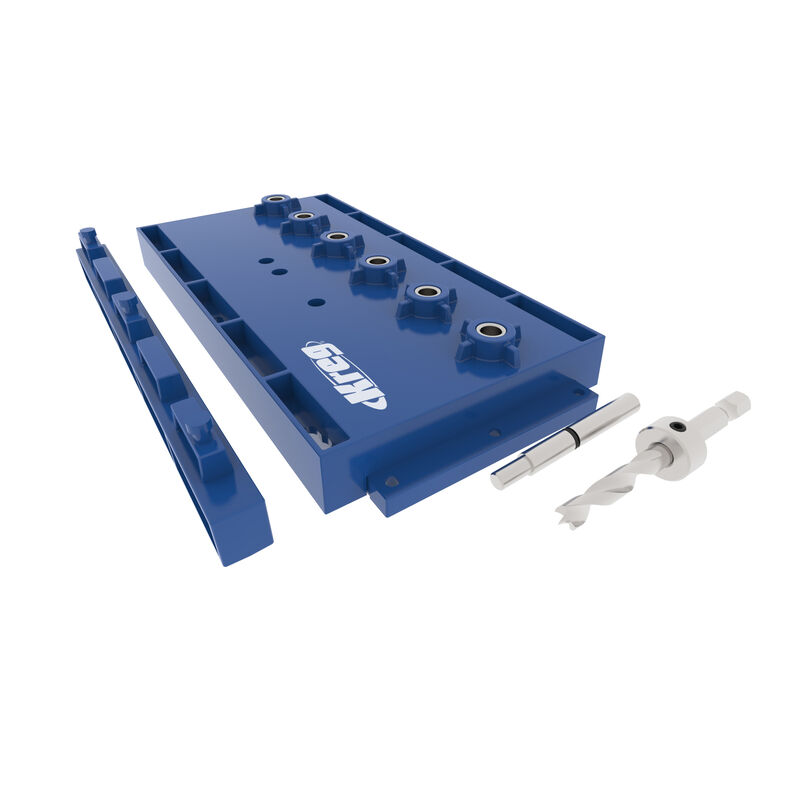The KMA3220 shelf pin jig from Kreg Tools is a quick and easy way to drill accurate holes for cabinet shelves at a standard distance of 32 mm centre to centre. I needed to fit adjustable shelving to a recent cabinet project. Alignment of the shelf pin holes is critical if you want level shelves that don’t rock and rattle. There are several easy DIY options to make shelf pin jigs; you can simply drill a line of holes into a piece of scrap board and use it to repeat the holes on your cabinet faces, or you can purchase a sheet of pegboard which has a grid of equally spaced holes that will achieve the same purpose.

There are a couple of shelf pin jigs on the market. I considered one from Triton Tools, but opted instead for the Kreg jig because of its hardened steel bushings that are less likely to be mangled by the drill bit. The jig is a rectangular construction in injection-moulded plastic. It comes with either a 5 mm or 1/4in brad-point drill bit depending on the model, a depth stop collar, a locating pin and a fence. The fence clips to either side of the jig to give either a 25 or 50 mm approximate backset, or the straight edge of the jig can be used widening the backset by approximately 12 mm.
Being an American design the jig is designed for imperial shelf pin sizes. Thus the 5 mm drill bit has a stepped shoulder to fit the 1/4in hardened steel guides. The rear of the jig has a pair of rotating clips which can be used to store the bit and the locating pin. Another clever design touch is that the moulding around the storage area for the bit also allows the depth stop to be quickly set to the correct position for any standard shelf pin, and they even provide an Allen key to tighten the depth stop.
Also in the pack you get 4 samples of shelf pin to match the drill bit size of the kit, and an attachment to secure two jigs together. This attachment is a perfect fit into either end of the jig, and allows multiple shelf pin jigs to be joined to form a longer jig for extended runs. Longer runs are possible with a single jig using the locator pin, which presses into the guide bush and into a pin hole that you drill using the jig to keep it in place. You can then drill the remaining five holes, before repositioning the jig and using the locating pin to keep it in position. The pin has a rubber gasket around its centre and is a very secure fit in the drill guide, so the jig doesn’t move when it is in position.
The bits are a relatively snug fit into the drill guides though there is a small amount of play. If you’re using a heavy drill and attempting to drill holes in the face of a pre-assembled cabinet, you may find that the holes do end up very slightly angled. As the provided bit has a hex shank it is actually possible to use a miniature 3.6V screwdriver to drill the holes, which can be useful in situations where space is tight or reach is difficult.
That said the jig works well if you take care to keep the drill straight. The bit is self-centring, so can’t wonder once it bites into the material surface. Keeping the jig pressed tightly against the edge of the reference surface and keeping the jig from moving as you move your drill between holes is essential. But used properly it is an excellent way to produce accurate shelf holes in cabinets, providing the faces and edges of the cabinet sides are square with one another. Though my jig has had minimal use, I noticed no unexpected wear on the guide bushes. Only the surrounding plastic shows signs of use where it makes contact with the depth collar, but that is to be expected. A jig like this will far outlast a piece of scrap board or pegboard, both of which will start to become less accurate as soon as they are first used. For that reason alone the Kreg jig is well worth the money.


Share Your Thoughts